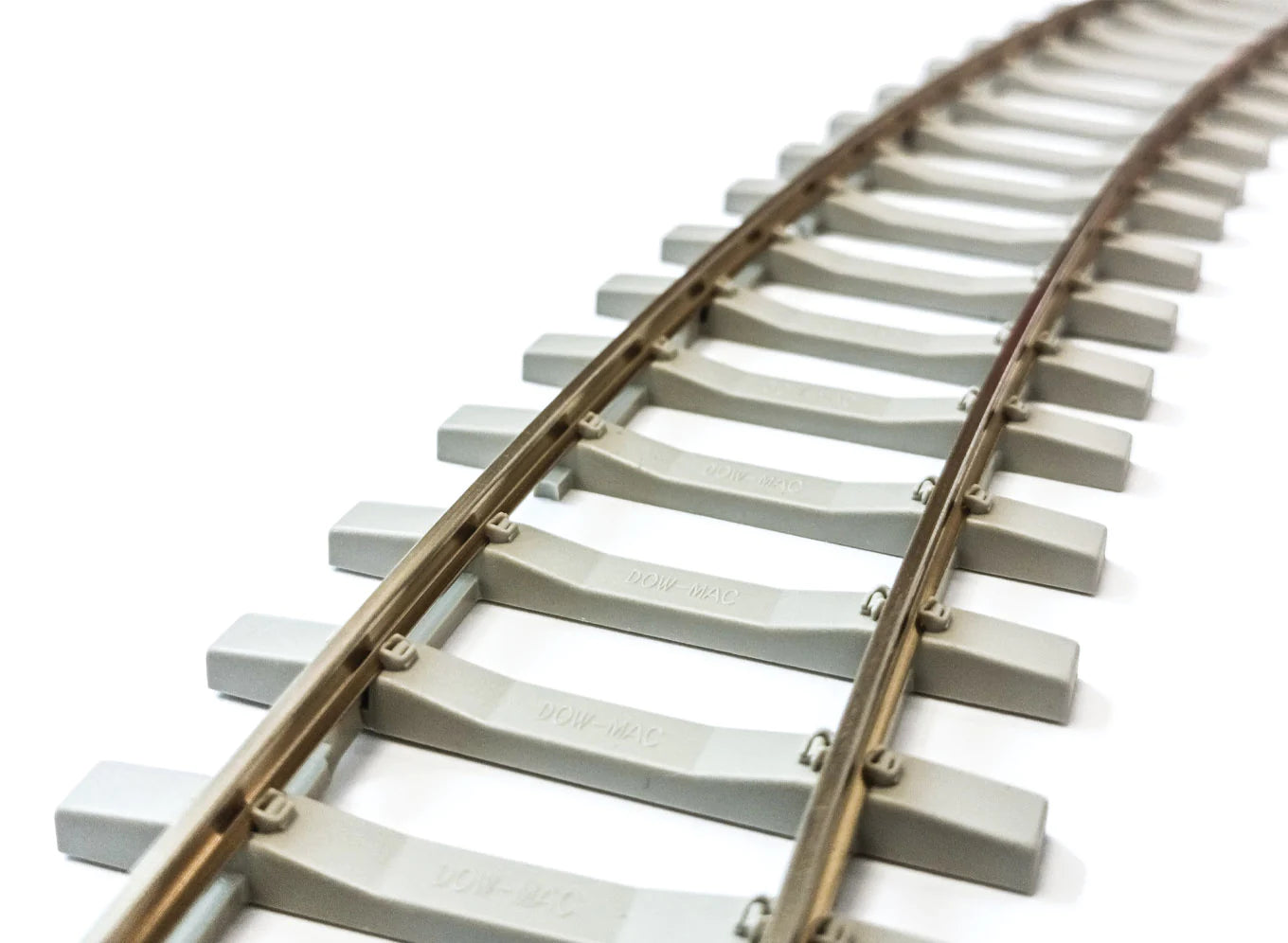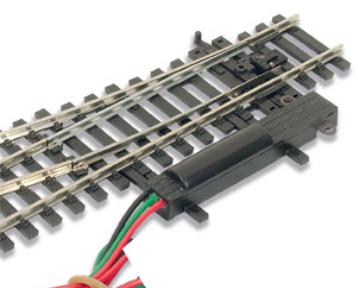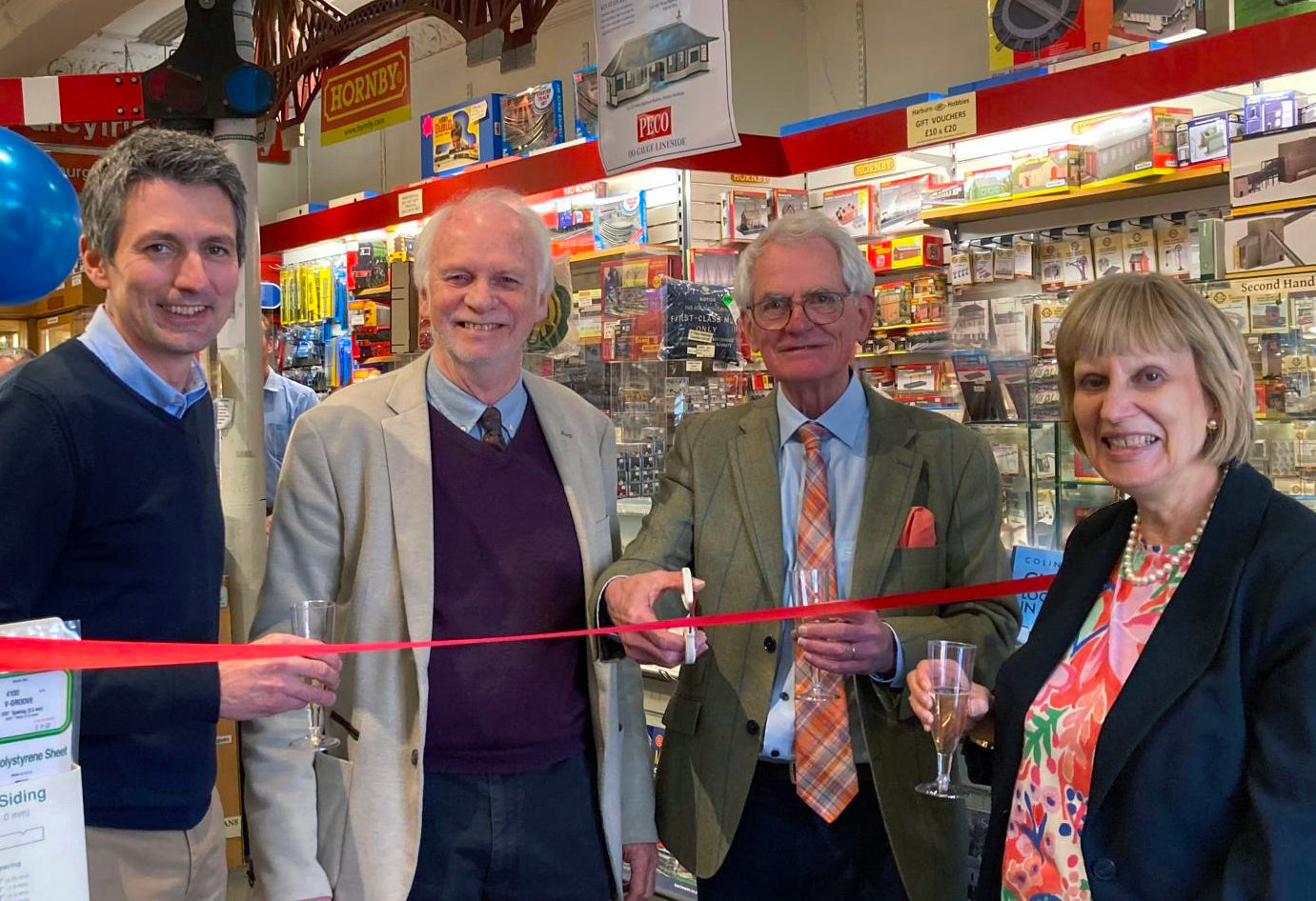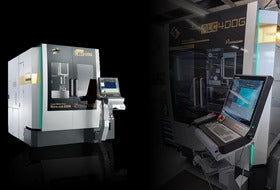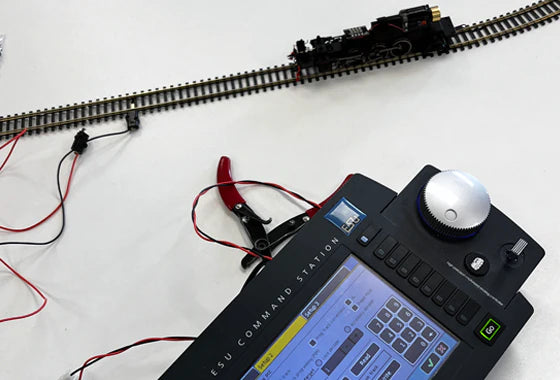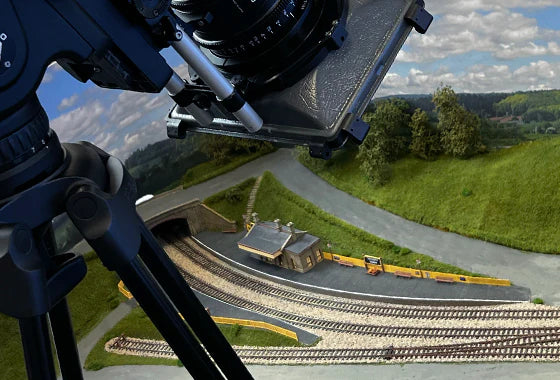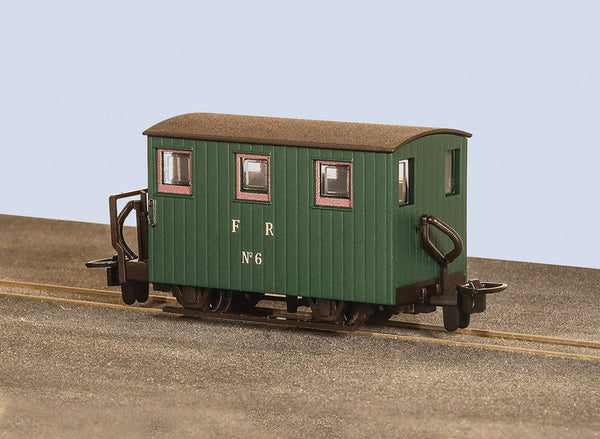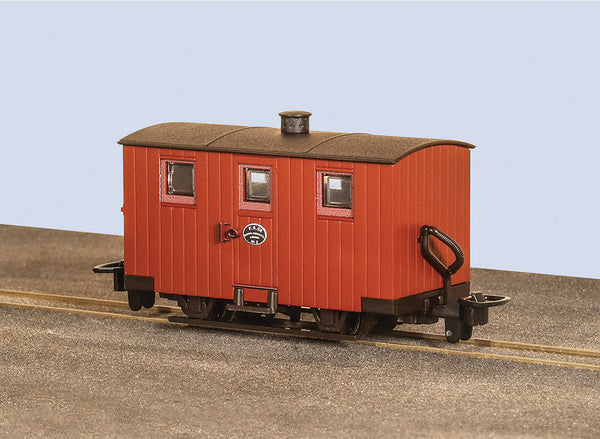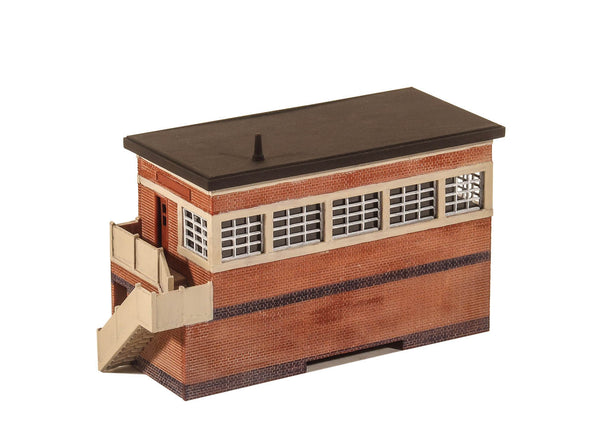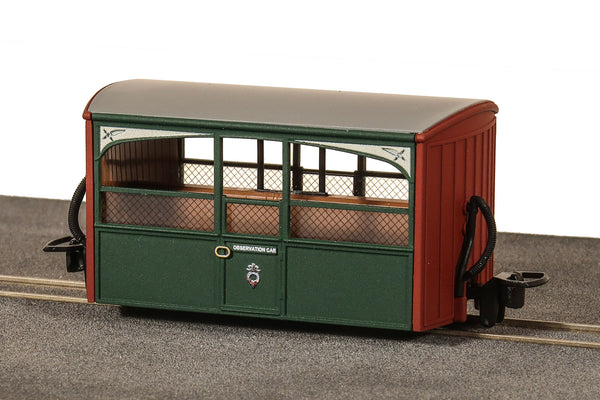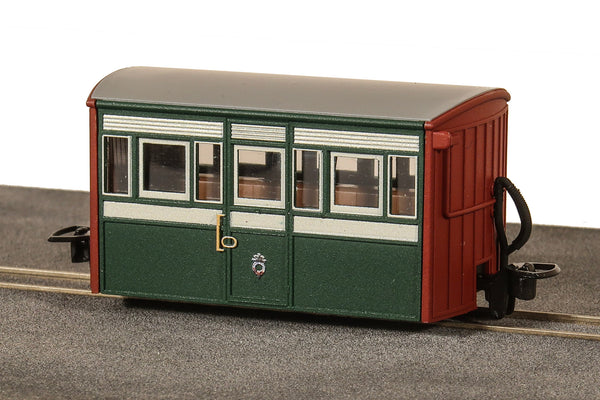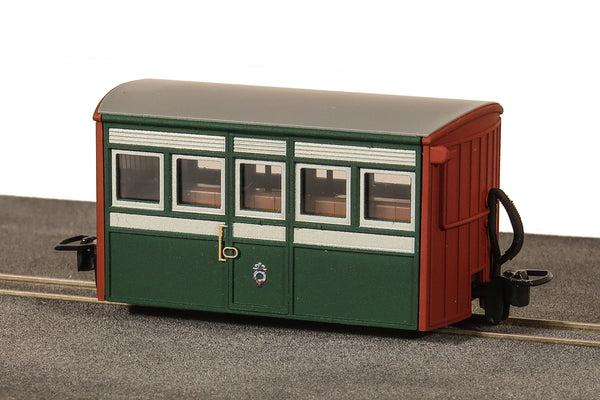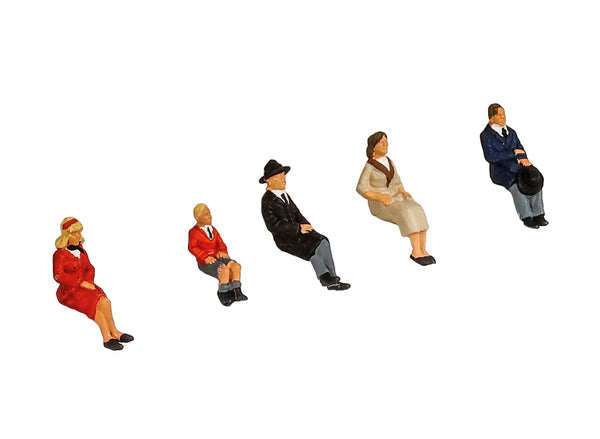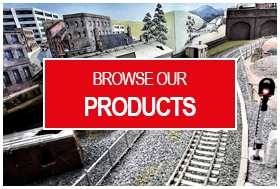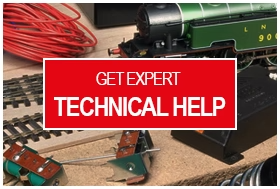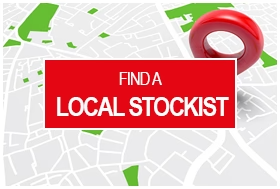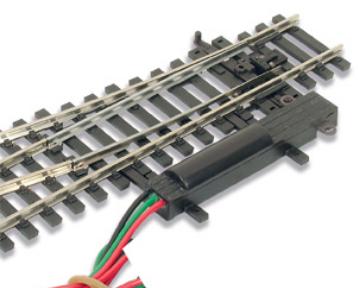BROWSE PECO PRODUCTS
Browse through our complete product portfolio.
101 Products Found
OO-9 FR Quarryman Coach, Green, Brake Coach (Single Balcony)
From 1867 the Ffestiniog Railway used dedicated carriages to carry workmen to and from the slate quarries around Blaenau Ffestiniog. From 1885 to 1887, eighteen of what are now referred to as the ‘Type 3’ Quarrymen’s carriage were built featuring sprung axle boxes, one central door on each side and droplight windows. More of the same design were made to replace the older carriages and there were a total of thirty-six in the 1900s. Archive images show a significant number of these coaches being used to transport workers to the quarry site.
 
OO-9 FR Quarryman Coach
From 1867 the Ffestiniog Railway used dedicated carriages to carry workmen to and from the slate quarries around Blaenau Ffestiniog. From 1885 to 1887, eighteen of what are now referred to as the ‘Type 3’ Quarrymen’s carriage were built featuring sprung axle boxes, one central door on each side and droplight windows. More of the same design were made to replace the older carriages and there were a total of thirty-six in the 1900s. Archive images show a significant number of these coaches being used to transport workers to the quarry site.
 
Bullhead OO Gauge Crossing
Bullhead track has been in use on the railways since the earliest times, and is still very much in evidence today. These superb turnouts give an authentic 00 scale look to your layout, and feature metal check rails and prototypical machined turnout blades.
Another feature of these turnouts is that both routes remain electrically live, making them ideal for DCC operation. They are constructed to our new versatile Unifrog design which can be operated, powered and switched like an Electrofrog or left unpowered if preferred.
Peco Streamline Code 75 track meets the standards of enthusiasts who prefer to run trains on scale height rail. Today most manufacturers' wheels are suitable for use on Code 75 track but some vintage models may have flanges which are too deep to clear the rail fixings. Code 75 can be easily combined with code 100 track by using the SL-113 Transition Track.
Bullhead OO Gauge Slip - Double
Bullhead track has been in use on the railways since the earliest times, and is still very much in evidence today. These superb turnouts give an authentic 00 scale look to your layout, and feature metal check rails and prototypical machined turnout blades.
Another feature of these turnouts is that both routes remain electrically live, making them ideal for DCC operation. They are constructed to our new versatile Unifrog design which can be operated, powered and switched like an Electrofrog or left unpowered if preferred.
Peco Streamline Code 75 track meets the standards of enthusiasts who prefer to run trains on scale height rail. Today most manufacturers' wheels are suitable for use on Code 75 track but some vintage models may have flanges which are too deep to clear the rail fixings. Code 75 can be easily combined with code 100 track by using the SL-113 Transition Track.
Bullhead OO Gauge Slip - Single
Bullhead track has been in use on the railways since the earliest times, and is still very much in evidence today. These superb turnouts give an authentic 00 scale look to your layout, and feature metal check rails and prototypical machined turnout blades.
Another feature of these turnouts is that both routes remain electrically live, making them ideal for DCC operation. They are constructed to our new versatile Unifrog design which can be operated, powered and switched like an Electrofrog or left unpowered if preferred.
Peco Streamline Code 75 track meets the standards of enthusiasts who prefer to run trains on scale height rail. Today most manufacturers' wheels are suitable for use on Code 75 track but some vintage models may have flanges which are too deep to clear the rail fixings. Code 75 can be easily combined with code 100 track by using the SL-113 Transition Track.
ARP Signal Box
These specially reinforced ARP (Air Raid Precautions) signal boxes featured substantial construction, primarily to protect the locking room gear from bomb blasts during air raids in World War II. A number of similar signal box designs were still to be found around the rail network until quite recently, due to them being difficult to demolish!
The 259 includes all moulded parts required which are produced to a high standard and in base colours. Kit requires painting and light weathering to create the signal box pictured above.
OO-9 FR Bug Box Coach, Zoo Car, Early Preservation Livery
The curiously-named "bug Box" 4-wheel coaches were the first passenger carrying coaches built for the Ffestiniog Railway. Dating from 1864 to 1867 they were built by Brown, Marshall & company. The term "Bug Box is a more recent term given to them, possibly in the 1950s, and originally they were referred to as "Small Birmingham's".
There are three types of vehicle: First Class, Third Class, and Open third, sometimes referred to as “Zoo” cars.
OO-9 FR Bug Box Coach, 3rd Class, Early Preservation Livery
The curiously-named "bug Box" 4-wheel coaches were the first passenger carrying coaches built for the Ffestiniog Railway. Dating from 1864 to 1867 they were built by Brown, Marshall & company. The term "Bug Box is a more recent term given to them, possibly in the 1950s, and originally they were referred to as "Small Birmingham's".
There are three types of vehicle: First Class, Third Class, and Open third, sometimes referred to as “Zoo” cars.
OO-9 FR Bug Box Coach, 1st Class, Early Preservation Livery
The curiously-named "bug Box" 4-wheel coaches were the first passenger carrying coaches built for the Ffestiniog Railway. Dating from 1864 to 1867 they were built by Brown, Marshall & company. The term "Bug Box is a more recent term given to them, possibly in the 1950s, and originally they were referred to as "Small Birmingham's".
There are three types of vehicle: First Class, Third Class, and Open third, sometimes referred to as “Zoo” cars.
ARP Signal Box
These specially reinforced ARP (Air Raid Precautions) signal boxes featured substantial construction, primarily to protect the locking room gear from bomb blasts during air raids in World War II. A number of similar signal box designs were still to be found around the rail network until quite recently, due to them being difficult to demolish!
The 554 includes all moulded parts required which are produced to a high standard and in base colours. Kit requires painting and light weathering to create the signal box pictured above.
Signal Box Interior
A kit containing common objects found in any signal box, such as the comfy leather armchair, stove, token machines, desk, a shelf with various rule books lined up, a phone, a clock, and the most important items, the kettle and mug of tea.
Seated People
Pack contains 5 standing people for all OO scenes. Each pack contains 5 different characters all hand painted.
